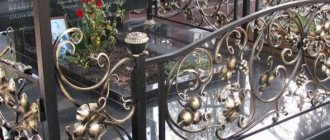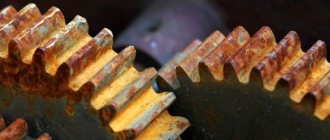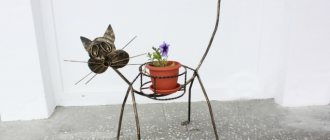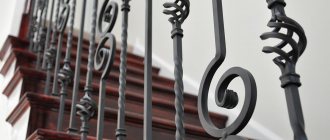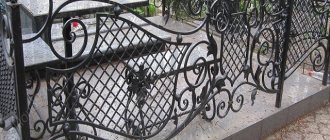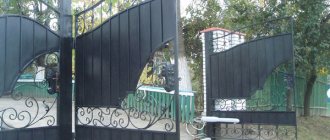Forged roses in a cemetery
Flowers in a cemetery symbolize the transience of our life - this is an expression of your feelings for the deceased, saying that he is not forgotten, and we are still loved.
Natural flowers, unfortunately, wither very quickly, and artificial ones lose their appearance after the first rainfall, wind, or sunlight. And I really want the grave of a loved one to be decorated with beautiful, noble flowers, for example, roses.
Roses, in the ritual sphere, are a symbol of deep, sincere feelings, eternal memory and sorrow. Therefore, your love and respect for the deceased can be expressed through these symbolic details. They not only express your feelings, but also decorate the burial and attract the attention of passers-by.
Video of the process of making forged roses in our forge
And yet, for whom are we creating these roses?
- Firstly, a forged rose is the best gift for your beloved. Because there is no more romantic way to confess your love to her than to say that you will love her until this rose withers.
- Secondly, this is a royal gift for the most gentle, most refined natures, connoisseurs of everything beautiful and unusual, for women. Mom, sister, daughter, distant relative, your colleague at work, friend and just a friend will be delighted with such a rose.
- Thirdly, this is an unusual gift for those who do not like boring interiors. Such a rose will dilute any interior and will definitely become the center of attention.
- Fourthly, this rose is for practical people. After all, many people love Flowers, but are very upset when they wither. Our rose will never wither; it can be passed on to generations.
Forging a rose from a single piece of metal.
For clarity, we present an illustration from the book Secrets of Blacksmithing , more details about it can be found in the article “Books on blacksmithing”
The rose itself is created from a material suitable for forging. We will create our rose from a cylindrical blank. The diameter of the workpiece should be slightly smaller than the future rose. We stretch one side of the cylinder onto the square so that the remaining part is larger, since we will make petals from it. Typically, three layers of metal are used for the petals. We divide the remaining part of the cylinder into three parts, and apply notches to each of them towards the cylinder axis. In the center we keep the material of the same thickness as that of the part of the cylinder stretched to a square. As a result, we get three layers of metal overlapping each other. In the forming plate they are all settled to a thickness of 2 mm and a size close to the size of the rose you want.
Next, we make the petals of our rose from sheets of metal. We cut towards the center to get the petals to overlap. The resulting petals need to be riveted onto the anvil horn and placed in a bud. We make the petals of the second and third layers in the same way, changing only the sizes. Each next layer of petals is larger than the previous one. When adding the next layer, we re-cut out the flower rosettes. The petals of the last layer should be straighter than the petals of the previous layers, so we give it a greater resemblance to a living flower. The work on the bud is finished, it’s time to work on the stem.
Heat the rod stretched through the square until it becomes elastic enough to be shaped into a rose stem. The final stage is to warm up the rose and apply the finishing touches to enhance the resemblance to a living flower.
Forged rose. Copper.
Copper forged rose 1
Copper forged rose 1
Forged copper rose 2
Forged copper rose 2
Rose forged copper 3
Rose forged copper 3
Forged rose. Silver.
Rose forged in silver 1
Rose forged in silver 1
Forged rose silver 2
Forged rose silver 2
Forged rose silver plated 3
Forged rose silver plated 3
Forging
Forging a rose using this method uses all the skills of blacksmithing and the appropriate tools.
In essence, the basic technology is similar to that described in the previous section with the addition of basic Kuznetsk operations.
You will need rolled stock in the form of a 6 mm rod and 2-2.5 mm sheet steel for blanks for the petals of the future flower.
The rod is heated at one end and the edge is thickened. This can be done by holding it in a vice and using blows from the end to form a thickening.
To conveniently secure the petals around the thickening circle of the rod, you can make a groove with a chisel on the heated metal.
Blanks in the form of petals and crosses are cut from sheet steel in the same way as in the above method.
Each of the petals is pre-forged and thinned at the edges, dispersing the metal. At the same time, you can still create the veins inherent in a natural rose.
Before assembly, you can make thorns on the stem. To do this, you need to make thickenings on the rod using the planting technique, which are then, after securing the stem in a vice, formed into spikes.
Start assembling the flower from the prepared elements.
Each of the four-lobed parts is placed on a rod and welded. In this case, each element must be scrolled, making the desired shape. Also, after assembly, using pliers, give the product the desired volume and contours.
If you wish, you can also attach foliage to the stem. Each leaf is produced using the blacksmith method from a 2 mm steel sheet. A cutting is pulled from it, which is used to attach the element to the stem.
At the end of the work, the flower is cleaned of slag and soot.
You can also do a type of finishing such as bluing. To do this, you will need to apply a thin layer of unrefined oil to the product and heat it in the oven until the applied ingredient is covered with a varnish crust.
As a result of such blacksmithing “floriculture” the following result should be obtained:
Forged rose. Gold.
Rose forged gold plated 1
Rose forged gold plated 1
Forged gold rose 2
Forged gold rose 2
Gold forged rose 3
Gold forged rose 3
Bouquet of forged roses
Three forged roses
Three forged roses
Bouquet of forged roses
Bouquet of forged roses
Forged roses
Forged roses
So, a forged rose is a special chic. It combines the grace of nature and the coldness of metal. A rose born in fire can be a unique decorative element, a unique gift, or even a declaration of eternal love.
Making a rose from metal
Despite the fact that such flowers are called forged, you can make a rose from metal with your own hands without blacksmithing. Amateur-level welding skills are sufficient.
Materials and tools
Petals and leaves are made from sheet steel 0.3 - 0.8 mm thick or metal from the hoods and fenders of old cars. When choosing, you should take into account that thin iron has a high probability of burning through during welding, and thick material is more difficult to give the desired shape. The stem is made from reinforcing rod or knitting wire with a diameter of 8 - 12 mm. For finishing you will need unrefined or motor oil.
To create an iron rose with your own hands, you cannot do without the following tools:
- semi-automatic welding machine or inverter with electrodes with a diameter of 2 mm;
- grinder or grinder;
- metal scissors;
- electric drill with a set of drills with a diameter of up to 10 mm;
- gas burner or autogen;
- pliers and round nose pliers;
- felt-tip pen.
Making preparations for the future rose
A complex drawing is not needed for the work, since due to inaccuracies the flower will look more natural. If you plan to make a bouquet, prepare templates from thick paper or cardboard. To create an ordinary rose, 4 square blanks for petals with a side of 10 cm are cut out of a sheet of metal. To make the bud more magnificent, add another one. On one square there is a 4-pointed star in the form of a compass rose. This will be the sepal located under the flower. On the remaining squares, draw a schematic 4-petalled flower.
First, a drawing is made and petals are cut out of paper
For a lush metallic tea rose with many petals, the blanks are marked differently:
- the sepal is drawn in the form of a 5-pointed star in a circle with a diameter of 7 - 8 cm;
- on the first blank with a circumference of 11 - 12 cm, draw a flower with 5 petals;
- on the 2nd and 3rd with a diameter of 10 - 11 cm, 4 petals are placed;
- on the 4th circle with a diameter of 10 cm there will be 3 petals;
- on the 5th with a diameter of 9 cm, draw 4 narrow petals.
Metal blanks are cut
Mark 2 - 3 leaves of different sizes. Depending on the thickness of the metal, the blanks are cut with a grinder or scissors, without touching the central part. Notches are applied to the edges of the leaves.
Forged roses after production in our blacksmith shop
Forged rose bud
Forged rose bud
Forged rose
Forged rose
Rose after making
Rose after making
Forged rose leaves
Forged rose leaves
Forged rose stem
Forged rose stem
Rose bud and stem, forging
Rose bud and stem, forging
Three forged roses after production
Three forged roses after production
Bouquet of forged roses
Bouquet of forged roses
Methods for forging roses
If you look for information on making a rose flower from metal using the blacksmith method, you can find many different techniques and techniques. The simplest of them are practically metalwork works with a minimum of forging. But there are also methods when a rose is made from one solid piece, using only forging technologies.
So, in what ways is a forged rose created?
Assembly from individual parts
To make a flower in this way, you will need a minimum of metal working skills. Blanks needed: rod 5-6 mm and sheet steel 1-1.5 mm.
The sheets are cut into blanks in the form of four interconnected petals. You will need 3 of them to get a completely voluminous flower.
Also, a cross in the form of pointed four petals is cut out from this sheet.
The next step is to take a rod, the end of which is heated and riveted. Then they move on to assembly.
Four-lobe blanks are placed on the end of the rod and welded on the outside.
Each of the elements is heated and twisted, gradually forming a flower.
After securing the first petal, all the rest are threaded with a rod from the other end.
When all the petals are installed, put on a cross, and the flower itself is heated and given the desired shape with pliers.
When the final finishing of the metal rose is completed, the flower must be burned and cleaned of traces of slag and burning. Additionally, you can work the stem with thorns and make leaves. The product should look like in the photo
But this method is more technically metalworking and welding than the Kuznetsk method. After all, blacksmithing techniques are practically not used. However, the method is original and easy to implement. Especially for those who do not have the appropriate equipment. How to make a rose using forged metal?
